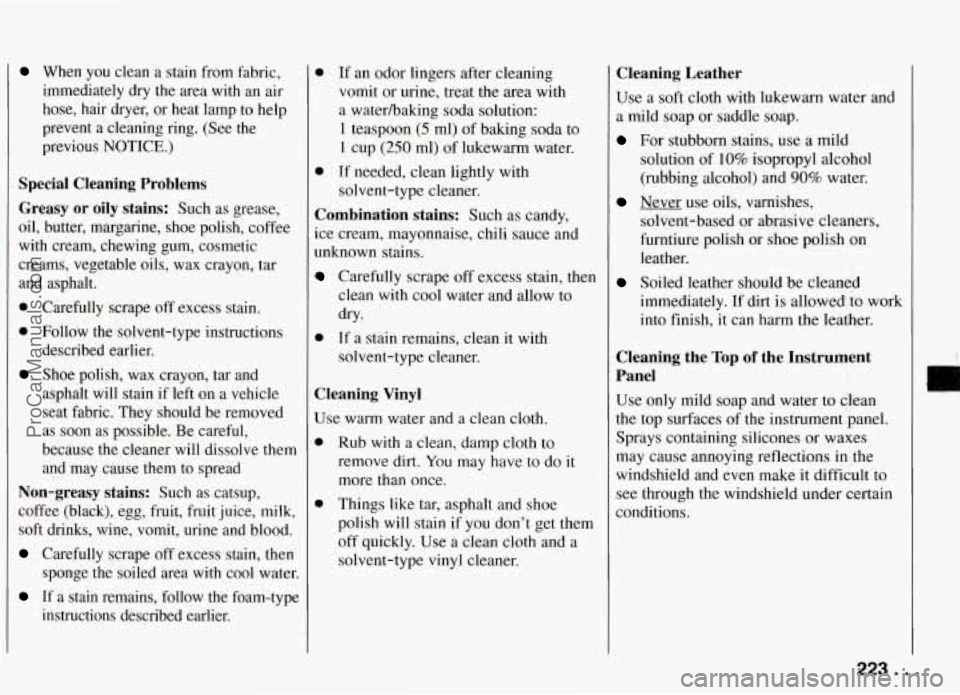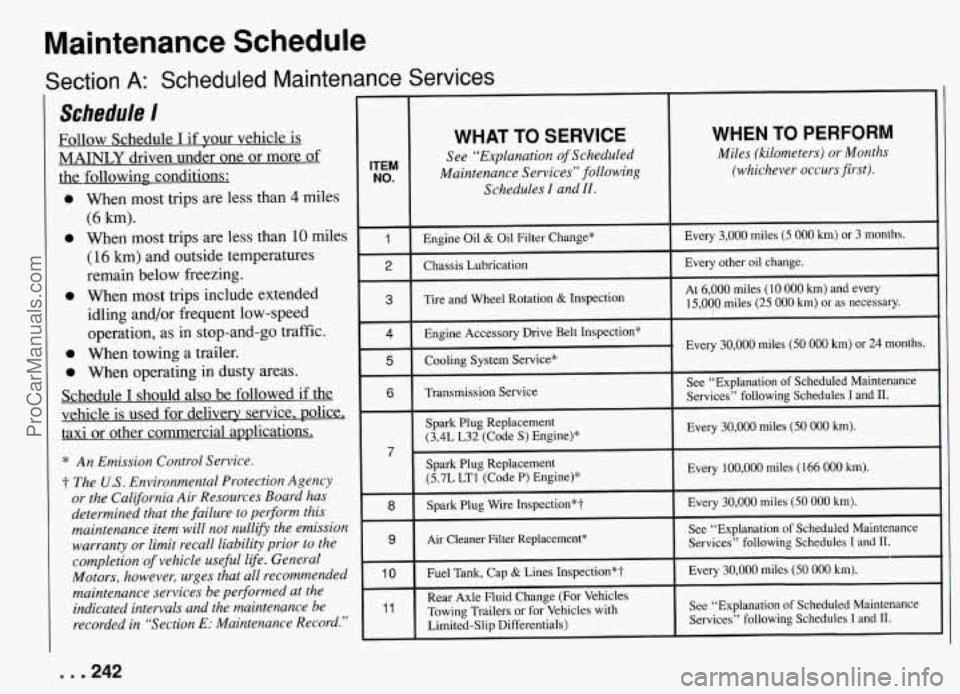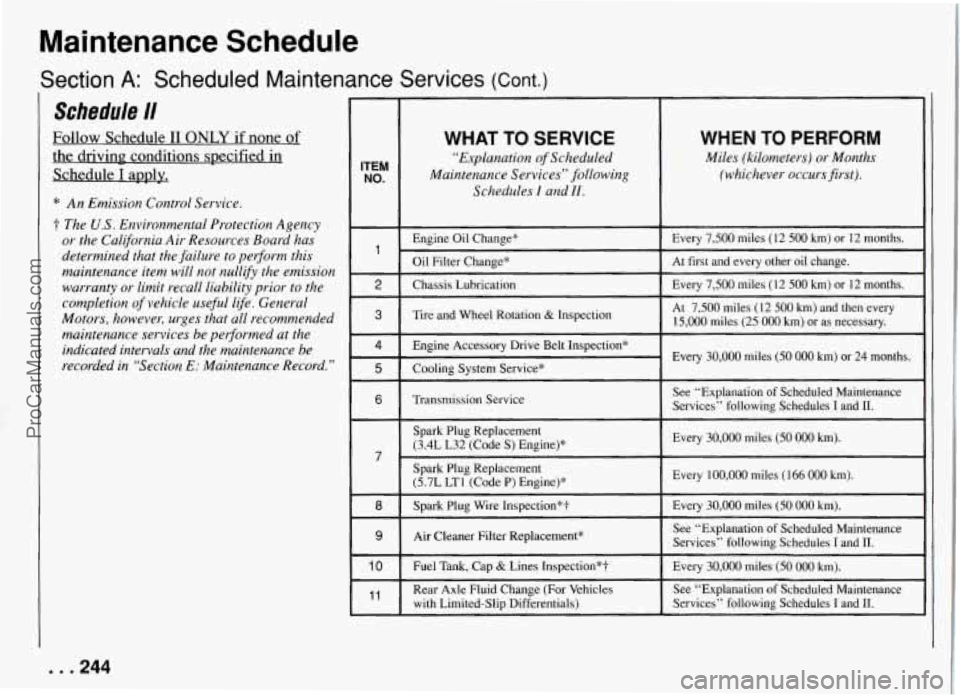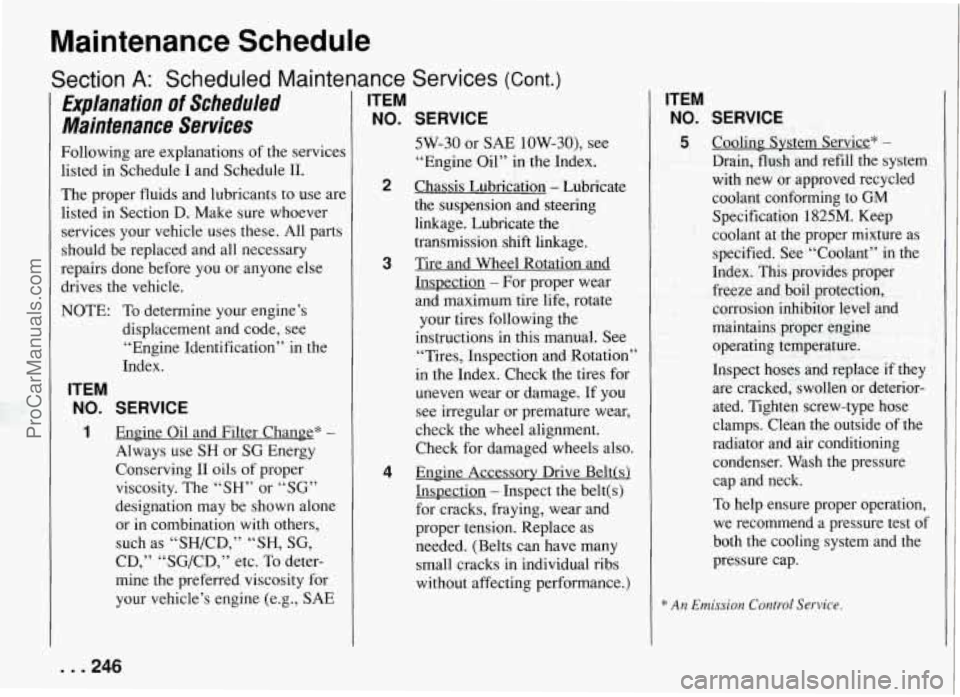air condition PONTIAC FIREBIRD 1994 User Guide
[x] Cancel search | Manufacturer: PONTIAC, Model Year: 1994, Model line: FIREBIRD, Model: PONTIAC FIREBIRD 1994Pages: 290, PDF Size: 14.84 MB
Page 224 of 290

When you clean a stain from fabric,
immediately dry the area with an air
hose, hair dryer, or heat lamp to help
prevent a cleaning ring. (See
the
previous NOTICE.)
Special Cleaning Problems
Greasy or oily stains:
Such as grease,
oil, butter, margarine, shoe polish, coffee
with cream, chewing gum, cosmetic
creams, vegetable oils, wax crayon, tar
and asphalt.
0 Carefully scrape off excess stain.
0 Follow the solvent-type instructions
Shoe polish, wax crayon, tar and described earlier.
asphalt will stain if left on a vehicle
seat fabric. They should be removed
as soon as possible. Be careful,
because the cleaner will dissolve them
and may cause
them to spread
Non-greasy stains: Such as catsup,
coffee (black), egg, fruit, fruit juice, milk,
soft drinks, wine, vomit, urine and blood.
Carefully scrape off excess stain, then
sponge
the soiled area with cool water.
If a stain remains, follow the foam-type
instructions described earlier. If an
odor lingers after cleaning
vomit or urine, treat the area with
a waterhaking soda solution:
1 teaspoon (5 ml) of baking soda to
1 cup
(250 ml) of lukewarm water.
If needed, clean lightly with
solvent-type cleaner.
Combination stains: Such as candy,
ice cream, mayonnaise, chili sauce and
lnknown stains.
Carefully scrape off excess stain, then
clean with cool water and allow to
dry-
@ If a stain remains, clean it with
solvent-type cleaner.
Cleaning Vinyl
Use warm water and a clean cloth.
Rub with a clean, damp cloth to
remove dirt. You may have to do it
more than once.
Things like tar, asphalt and shoe
polish will stain if you don’t get them
off quickly. Use a clean cloth and a
solvent-type vinyl cleaner.
Cleaning Leather
Use a soft cloth with lukewarn water and
a mild soap or saddle soap.
For stubborn stains, use a mild
solution of
10% isopropyl alcohol
(rubbing alcohol) and
90% water.
solvent-based or abrasive cleaners,
furntiure polish or shoe polish on
leather.
immediately. If dirt is allowed,to work
into finish, it can harm the leather.
Cleaning the Top of the Instrument
Panel
Use only mild soap and water to Clean
the top surfaces of the instrument.pane1.
Sprays containing silicones or waxes
may cause annoying reflections in the
windshield and even make it difficult to
see through the windshield under certain
conditions.
Never use oils, varnishes,
Soiled leather should be cleaned
223. . .
ProCarManuals.com
Page 227 of 290

Service and Appearance Care
Sheet Metal Damage
If your vehicle is damaged and requires
sheet metal repair or replacement, make
sure the body repair shop applies
anti-corrosion material to the parts
repaired or replaced to restore corrosion
protection.
Foreign Material
Calc'ium chloride and other salts, ice
melting agents, road oil and tar, tree sap,
bird droppings, chemicals from industrial chimneys, and other foreign matter can
damage your vehicle's finish
if they
remain on painted surfaces. Use cleaners
that are marked safe for painted surfaces
to remove foreign matter.
Finish Damage
Any stone chips, fractures or deep
scratches in the finish should be repaired
right away. Bare metal will corrode
quickly and may develop into a major
repair expense.
Minor chips and scratches can be repaired
with touch-up materials available from
your dealer or other service outlets.
Larger areas of finish damage can be corrected
in your dealer's body and paint
shop.
Underbody Maintenance
Chemicals used for ice and snow removal
and dust control can collect on the
underbody. If these are not removed,
accelerated corrosion (rust) can occur on
the underbody parts such as fuel lines,
frame, floor pan, and exhaust system even
though they have corrosion protection.
At least every spring, flush these
materials from the underbody with plain
water. Clean any areas where mud and
other debris cah collect. Dirt packed in
closed areas
of the frame should be
loosened before being flushed. Your
dealer or an underbody vehicle washing
system can do this for you.
Chemical Paint Spotting
Some weather and atmospheric conditions
:an create a chemical fallout. Airborne
?ollutants can fall upon and attack painted
curfaces on your vehicle. This damage
:an take two forms: blotchy,
inglet-shaped discolorations, and small
irregular dark spots etched into the paint
surface.
Although no defect in the paint job causes
this, Pontiac will repair, at no charge to
the owner, the surfaces of new vehicles
jamaged by this fallout condition within
12 months or 12,000 miles (20
000 km)
of purchase, whichever comes first.
. . ,226
ProCarManuals.com
Page 231 of 290

Service and Appearance Care
Main Fuse Block
1 - Air Bag: SIR Components
2 - Backup Lights; Daytime Running (15
Amp.)
Lights Module (Canada); Turn
Flasher
(20 Amp.)
3 - HVAC Selector Switch (Heater/Ail
Conditioner); Rear Defogger
(25 Amp.)
4 - Powertrain Control Module;
Instrument Cluster; PASS-Key
II@
Decoder Module (10 Amp.)
5 - Powertrain Control Module;
PASS-Key
11s Decoder Module;
Fuel Pump Relay (15 Amp.)
;
6 - Brake LightKruise Release
Switch; Hazard Flasher
(20 Amp.)
7 - Power Door Locks; Power Mirrors;
Hatch Release (15 Amp.)
8
- Audio Alarm Module; Base@
Relay; Courtesy Lights: Console
Compartment, Glove Box, Dome,
Trunk, Rear Courtesy, Rearview
Mirror and Radio (15 Amp.)
9 - Audio Alarm Module; Daytime
Running Lights Module (Canada);
Diagnostic Energy Reserve
Module; Instrument Cluster; Remote Lock Control Module
( 10 Amp.)
10 - Exterior Lighting (20 Amp.)
11 - Cigarette Lighter; Horn Relay
12 - Power Seats; Rear Defogger
13 - Brightness Control (5 Amp.)
14 - Windshield Wipermasher
(25 Amp.)
15 - Power Windows, Convertible
Top Switch
(30 Amp. Circuit
Breaker)
Module
(3 Amp.)
(15 Amp.)
(25 Amp.)
(30 Amp. Circuit Breaker)
16 - Diagnostic Energy Reserve
17 - Radio; Steering Wheel Controls
. . ,230
ProCarManuals.com
Page 232 of 290

C B
G H J
Underhood Electrical Center
Fuses
1 - Electronic Brake Control Module
(5 Amp.)
2
- Fog Lamps (20 Amp.)
3 - HeadIight Doors Module (15
4 - Headlight Doors Module (1 5
5 - Anti-Lock Brake System (5 Amp.)
6 - Coolant Fan Relays; EVAP Canister Purge Solenoid; Exhaust
Gas Recirculation; Low Coolant
Relay; Reverse Lockout Solenoid
(10 Amp.)
Amp.)
Amp.)
7 - Air
Injection Pump Assembly;
8 - Not Used
9 - Fuel Injectors (7.5 Amp.)
10 - Fuel Injectors (7.5 Amp.)
11 - VIN Engine Code S: Camshaft
Air
Pump Relay
(20 Amp.)
Position Sensor; Crankshaft Position Sensor; Electronic
Ignition Module
(10 Amp.)
VIN Engine Code P: Ignition
Coil; Ignition Coil Driver
(10 Amp.)
12 - Air Conditioning Compressor
Relay; Cruise Control Switches
and Module
(20 Amp.)
Relays
B - Air Conditioning Compressor
C - Anti-Lock Brake System
D - Primary Coolant Fan (Driver Side)
E - Air Pump
F - Secondary Coolant Fan
(Passenger Side)
G - Traction Control System
H - Fog Lamps
J - Not Used
231 . ..
ProCarManuals.com
Page 236 of 290

tNot all air conditioning refrigerants are the same. If the air con\
ditioning system in your
vehicle needs refrigerant, be sure the proper refrigerant is us\
ed. If you’re not sure, ask
your Pontiac dealer.
“Recheck fluid level after filling. See “Automatic Transmission Fluid” in the Index.
235. . .
ProCarManuals.com
Page 241 of 290

Maintenance Schedule
Introduction: A Word about Maintenance
We at General Motors want to help you
keep your vehicle in good working
condition. But we don’t know exactly
how you’ll drive it. You may drive very
short distances only a
few times a week.
Or you may drive long distances all the
time in very hot, dusty weather. You may
use your vehicle in making deliveries. Or
you may drive it to work, to do errands,
or in many other ways.
Because of all the different ways people
use their GM vehicles, maintenance needs
vary. You may even need more frequent
checks and replacements than you will
find in the schedules
in this part. So
please read this part and note how you
drive.
If you have any questions on how
to keep your vehicle in good condition,
see your Pontiac dealer, the place
many GM owners choose to have their
maintenance work done.
Your dealer can
be relied upon to use proper parts and
practices.
Your Vehicle and the
Environment
Proper vehicle maintenance not only
helps to keep your vehicle in good
working condition, but also helps the
environment. All recommended
maintenance procedures are important. Improper vehicle maintenance or the
removal of important components can
significantly affect the quality of the air
we breathe. Improper fluid levels or even
the wrong tire inflation can increase the
level of emissions from your vehicle.
To
help protect our environment, and to help
keep your vehicle in good condition,
please maintain your vehlcle properly.
How This Part is Organized
The remainder of this part is divided into
five sections:
“Section
A: Scheduled Maintenance
Services” shows what to have done and
how often. Some of these services can be
complex,
so unless you are technically
qualified and have the necessary
equipment, you should let your dealer’s service department or another qualified
service center do these jobs.
If you are skilled enough to do some work
on your vehicle, you will probably want
to get the service information GM
publishes. You will find a list of
publications and how to get them in
this
manpal. See “Service Publications” in the
Index.
“Section
B: Owner Checks and Services’’
tells you what should be checked
whenever you stop for fuel. It also
explains what you can easily do
to help
keep your vehicle in good condition.
. . .240
ProCarManuals.com
Page 242 of 290

“Section C: Periodic Maintenance
Inspections” explains important
inspections that your Pontiac dealer’s
service department or another qualified
service center should perform.
“Section
D: Recommended Fluids and
Lubricants” lists some products GM
recommends to help keep your vehicle
properly maintained. These products,
or
their equivalents, should be used whether
you do the work yourself or have it done.
“Section
E: Maintenance Record”
provides a place for you to record the
maintenance perfowed on your vehicle.
Whenever any maintenance is performed,
be
sure to write it down in this section.
This will help you determine when your
next maintenance should be done. In
addition, it is a good idea to keep your
maintenance receipts. They may be
needed to qualify your vehicle for
warranty repairs.
Using Your Maintenance
Schedules
This section tells you the maintenance
services you should have done and when
you should schedule them. Your Pontiac
dealer knows your vehicle best and wants
you to be happy
with it. If you go to your
dealer for your service needs, you’ll know
that GM-trained and supported service
people will perform the work using
genuine GM parts.
These schedules are for vehicles that:
carry passengers and cargo within
recommended limits. You will find
these limits on your vehicle’s
Tire-Loading Information label. See
“Loading Your Vehicle”
in the Index.
are driven on reasonable road surfaces
within legal driving limits.
use the recommended unleaded fuel.
See “Fuel” in the Index.
Selecting the Right Schedule
First you’ll need to decide which of the
two schedules is right for your vehicle.
Here’s how to decide which schedule to
follow:
Schedule
I
Is any one of these true for your vehicle?
Most trips are less than 4 miles (6 km).
Most trips are less than 10 miles (1 6
km) when outside temperatures are
below freezing.
0 The engine is at low speed most of the
time (as
in door-to-door delivery, or in
stop-and-go traffic).
e You operate your vehicle in dusty
e You tow a trailer.
If any one (or more) of these is true for
your driving, follow Schedule
I.
Schedule 11
Follow Schedule I1 QI& if none of the
above conditions is true.
areas.
241 . .
ProCarManuals.com
Page 243 of 290

Maintenance Schedule
C L Section A: Scheduled Maintenance Services
Schedule I
Follow Schedule I if your vehicle is
MAINLY driven under one or more of
the following conditions:
When most trips are less than
4 miles
(6 km).
When most trips are less than
10 miles
(16 km) and outside temperatures
remain below freezing.
When most trips include extended
idling and/or frequent low-speed
operation, as in stop-and-go traffic.
When towing a trailer.
When operating in dusty areas.
Schedule
I should also be followed if the
vehicle is used for delivery service. police,
taxi or other commercial aqdications.
* An Emission Control Service.
t The U.S. Environmental Protection Agency
or the California Air Resources Board has
determined that the failure to perform this
maintenance item will not nullify the emission
warranty
or limit recall liability prior to the
completion ‘of vehicle useful life. General
Motors, however, urges that all recommended
maintenance services be performed at the
indicated intervals and the maintenance be
recorded in “Section
E: Maintenance Record.”
ITEM NO.
-
1
3
-
4
6
-
7
9
11
WHAT TO SERVICE
See “Explanation of Scheduled
Maintenance Services” following
Schedules
I and II.
~
Engine Oil & Oil Filter Change*
Chassis Lubrication
Tire and Wheel Rotation
& Inspection
Engine Accessory Drive Belt Inspection*
Cooling System Service*
Transmission Service
Spark Plug Replacement
(3.4L L32 (Code
S) Engine)*
Spark Plug Replacement
(5.7L LTl (Code P) Engine)*
Spark Plug Wire Inspection*?’
Air Cleaner Filter Replacement*
Fuel Tank, Cap
& Lines Inspeclion*t
Rear Axle Fluid Change (For Vehicles
Towing Trailers or for Vehicles with
Limited-Slip Differentials)
WHEN TO PERFORM
Miles (kilometers) or Months
(whichever occursfirst).
Every 3,000 miles (5 000 km) or 3 months.
Every other oil change.
At
6,000 miles (10 000 km) and every
15,000 miles (25 000 km) or as necessary.
Every
30,000 miles (50 000 km) or 24 months.
See “Explanation of Scheduled Maintenance
Services” following Schedules I and
II.
Every 30,000 miles (50 000 km).
Every 100,000 miles (166 000 km).
Every 30,000 miles (50 000 km).
See “Explanation of Scheduled Maintenance
Services” following Schedules I and 11.
Every 30,000 miles
(50 000 km).
~ ~~ ~~~
See “Explanation of Scheduled Maintenance
Services” following Schedules
I and 11.
. . .242
ProCarManuals.com
Page 245 of 290

Maintenance Schedule
Section A: Scheduled Maintenance Services (Cont.)
Schedule lI
Follow Schedule II ONLY if none of
the driving. conditions specified in
Schedule
I apply.
* An Emission Control Service.
t The US. Environmental Protection Agency
or the California Air Resources Board has
determined that the failure to pedorm this
maintenance item will not nullify the emission
warranty or limit recall liability prior to the
completion
of vehicle useful life. General
Motors, however, urges that all recommended
maintenance services be performed at the
indicated intervals and the maintenance be
recorded in “Section
E: Maintenance Record.”
WHAT TO SERVICE WHEN TO PERFORM
“Explanation of Scheduled Miles (kilometers) or Months ITEM NO. Maintenance Services” following (whichever occursfirst).
Schedules
I and I?.
Engine Oil Change* Every 7,500 miles (12 500 km) or 12 months.
Oil Filter Change* At
first and every other oil change. 1
2 Chassis Lubrication Every 7,500 miles (12 500 km) or 12 months. ~~~
3 I Tire and Wheel Rotation & Inspection I
At 7,500 miles (12 500 km) and then every
15,000 miles (25
000 km) or as necessarv.
4 I Engine Accessory Drive Belt Inspection* ~ Every 30,000 miles (50 000 km) or 24 months.
5 I Cooling System Service* !
6 I Transmission Service I
See “Explanation of Scheduled Maintenance
Services” following Schedules
I and 11.
Spark Plug Replacement
(3.4L L32 (Code
S) Engine)* Every 30,000 miles (50 000 km).
7
I
Spark Plug Replacement
(5.7L LTl (Code P) Ennine)* I Every 100,000 miles (166 000 km). \- I I, I
8 Spark Plug Wire Inspection*? Every 30,000 miles (50 000 km).
9 Air Cleaner Filter Replacement* I I
See “Explanation of Scheduled Maintenance
Services” following Schedules
I and II.
10 Fuel Tank, Cap & Lines Inspection”? Every 30,000 miles (50 000 km).
, , Rear Axle Fluid Change (For Vehicles See “Explanation
of Scheduled Maintenance
with Limited-Slip Differentials) Services” following Schedules I and
11.
. . .244
ProCarManuals.com
Page 247 of 290

Maintenance Schedule
Section A: Scheduled Maintenance Services (Cont.)
Explanation of Scheduled
Maintenance Services
Following are explanations of the services
listed in Schedule I and Schedule
II.
The proper fluids and lubricants to use are
listed in Section
D. Make sure whoever
services your vehicle uses these. All parts
should be replaced and all necessary
repairs done before you or anyone else
drives the vehicle.
NOTE: To determine your engine’s
displacement and code, see
“Engine Identification” in the
Index.
ITEM
NO. SERVICE
1 Engine Oil and Filter Change* -
Always use SH or SG Energy
Conserving
I1 oils of proper
viscosity. The “SH” or “SG”
designation may be shown alone
or in combination with others,
such as “SH/CD,”
“SH, SG,
CD,” “SG/CD,” etc. To deter-
mine the preferred viscosity for
your vehicle’s engine (e.g., SAE
ITEM
NO.
2
3
4
SERVICE
5W-30 or SAE 10W-30), see
“Engine Oil” in the Index.
Chassis Lubrication
- Lubricate
the suspension and steering
linkage. Lubricate the
transmission
shift linkage.
Tire and Wheel Rotation and
InsDection
- For proper wear
and maximum tire life, rotate
your tires following the
instructions in this manual. See
“Tires, Inspection and Rotation”
in the Index. Check the tires for
uneven wear or damage. If you
see irregular or premature wear,
check the wheel alignment.
Check for damaged wheels also.
Engine Accessorv Drive Belt!s)
InsDection
- Inspect the belt(s)
for cracks, fraying, wear and
proper tension. Replace as
needed. (Belts can have many small cracks in individual ribs
without affecting performance.)
ITEM
NO. SERVICE
5 Cooling: System Service* -
Drain, flush and refill the system
with new or approved recycled
coolant conforming to GM
Specification 1825M. Keep
coolant at the proper mixture as specified. See “Coolant”
in the
Index. This provides proper
freeze and boil protection, corrosion inhibitor level and
maintains proper engine operating temperature.
Inspect hoses and replace if they
are cracked, swollen or deterior-
ated. Tighten screw-type hose
clamps. Clean the outside of the
radiator and air conditioning
condenser. Wash the pressure cap and neck.
To help ensure proper operation,
we recommend a pressure test of
both the cooling system and the
pressure cap.
* An Emission Control Service.
. . .246
ProCarManuals.com